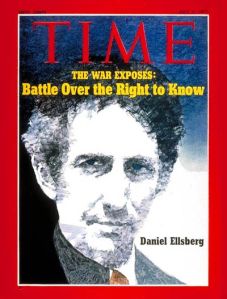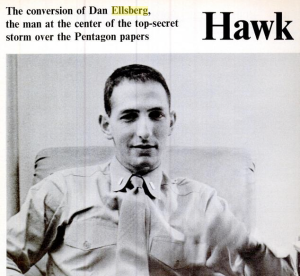
Edward Snowden, a 29-year-old defense contractor, came forward over the weekend as the whistleblower who gave secret documents about the U.S. government’s surveillance of internet and phone records to the media last week. “I have no intention of hiding who I am because I know I have done nothing wrong,” he told the Guardian.
TIME first summed up the significance of the Pentagon Papers leak in a June 28, 1971, cover story, “Pentagon Papers: The Secret War“:
The most instructive revelation may be how little faith the leaders had in those they led—a classic case of the arrogance of the powerful. The deceptions and misrepresentations stemmed from a conviction that the public would not face up to the harsh realities of Viet Nam. Even within the Government, sound intelligence estimates were often rudely ignored if they failed to fit policy preconceptions.
(MORE: Eric Snowden: A Modern-Day Daniel Ellsberg Except for One Key Difference)
TIME’s July 5, 1971, cover, “The War Exposés: Battle Over The Right to Know,” explored why such a leak would have been orchestrated by this man, who started out as a hawk and was a member of an “exceptional class” of elite scholars “who charged out of the nation’s best universities in the ’60s to apply mathematics and precise analysis to the waging of war”:
Ellsberg’s turnabout from confident hawk to disillusioned dove parallels the Viet Nam sentiments of millions of Americans. That sure feeling of the early ’60s that a quick application of U.S. manpower and machines would speedily hurl back the insurgent Communists and assure survival of an independent South Viet Nam faded years ago…If all the plans had worked, of course, there would have been no Pentagon paper revelations, no Ellsberg on TV, little talk about the immorality of the war.
(MORE: Ellsberg: The Battle Over The Right to Know)
And in a photo essay that reveals more of Ellsberg’s personal life, LIFE magazine ran a feature in its July 2, 1971 issue entitled, “Hawk Into Violent Dove: The conversion of Dan Ellsberg, the man at the center of the top-secret storm over the Pentagon papers.” The article begins: “The publication of Defense Department papers on the U.S. involvement in Vietnam has set off a historic debate on the limits of press freedom in the U.S.” It goes on to describe the young Ellsberg as “a talented schoolboy poet and pianist, then a brilliant scholar at Harvard and at Cambridge.”
MORE: Response to Revelations of NSA’s Data Collection Program: From Denial to Nonchalance
MORE: Bradley Manning and Our Real Secrecy Problem
LIST: Top 10 Leaks








